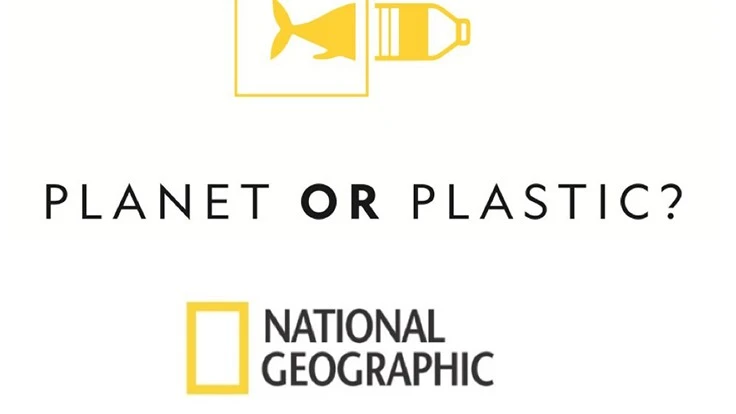
National Geographic has announced a new, global commitment to tackle the problem of single-use plastics with the launch of Planet or Plastic?, a multiyear initiative aimed at raising awareness and reducing the amount of single-use plastic that enters in the world’s oceans.
The American digital cable and satellite television network says its initiative will benefit the thousands to potentially millions of marine animals that become entangled in, suffocated by or ingest plastic each year, as well as contribute to the overall health of the planet’s marine ecosystems and all who rely upon them.
The organizationwide effort will include a research and scientific initiative; a consumer education and engagement campaign; updated internal corporate sustainability commitments; and partnerships with like-minded corporations and nongovernmental organizations (NGOs) from around the world, National Geographic says.
As a global brand with a history of scientific discovery and exploration, National Geographic says it is uniquely positioned to tackle this crisis in a way that only the network can—through storytelling and science.
“The Planet or Plastic? initiative will leverage the power of National Geographic’s media portfolio around the world and the expertise of National Geographic’s explorers and scientists who are witnessing firsthand the devastating impacts of this crisis,” says National Geographic in a press release announcing the initiative. “This organizationwide effort will include a major research and scientific initiative; a consumer education and engagement campaign; updated internal corporate sustainability commitments; and innovative partnerships with like-minded corporations and nongovernmental organizations (NGOs) from all over the world.”
The launch is tied to the release of the June issue of National Geographic magazine, which takes an in-depth look at the role single-use plastics play in society and the impact they are having on the environment. Starting with this issue, National Geographic has announced that it will begin wrapping the U.S., U.K. and India subscriber editions of the magazine in paper instead of plastic, with the goal of wrapping all global editions in paper by the end of 2019. The June issue is available online at natgeo.com/planetorplastic May 16 and on print newsstands May 29.
look at the role single-use plastics play in society and the impact they are having on the environment. Starting with this issue, National Geographic has announced that it will begin wrapping the U.S., U.K. and India subscriber editions of the magazine in paper instead of plastic, with the goal of wrapping all global editions in paper by the end of 2019. The June issue is available online at natgeo.com/planetorplastic May 16 and on print newsstands May 29.
“Each year, 9 million tons of plastic waste ends up in the ocean. Some estimates suggest this plastic could remain in marine environments for 450 years or longer, and the problem is only getting worse,” says National Geographic. “Addressing a challenge of this magnitude requires an unprecedented approach.”
In concert with the release of the June magazine, the Planet or Plastic? initiative will kick off with the following:
- Planet or Plastic? pledge: National Geographic asks audiences around the world to take the Planet or Plastic? pledge, a commitment to reduce their use of single-use plastic. By taking the pledge, individuals will become part of a global community working together to stem the tide of single-use plastic polluting the ocean and will continue to receive information and tips to help them in their efforts. The pledge marks the beginning of a comprehensive consumer awareness and engagement campaign that National Geographic will execute across its multiple platforms in the months and years to come. Elements of this campaign will range from inspiring and informative content, ongoing consumer engagement activities, events and more.
- Scientific research and identification: The nonprofit National Geographic Society will embark on a journey to better document how plastic travels from source to sea and to fill critical knowledge gaps. Starting with an initial expedition in 2019 to study the type and flow of plastic in a river system, National Geographic will provide science-based, actionable information to help local and national governments, NGOs, businesses and the public more effectively invest in and implement innovative solutions. The Society is also sourcing solutions to the challenge of plastic waste through an existing Reducing Marine Plastic Pollution Request for Proposal (RFP).
- Three-day social takeover: National Geographic will use the power and reach of its platforms to educate people about the impact of single-use plastic and to encourage them to take the pledge. For three days in May, National Geographic will “pollute” its Instagram feed, @natgeo, with photos of the plastics crisis as well as animated Instagram stories to highlight the true impact of humanity’s pollution of the natural world. The @natgeo Instagram feed will feature photos taken by photographer Randy Olson, who traveled around the world to document the plastics crisis and is featured in the June issue of the magazine. On Thursday, May 17, actress and singer Zooey Deschanel will curate National Geographic’s Instagram account, posting photos of the plastic crisis. On Friday, May 18, National Geographic’s photographers will be posting their own photos of the crisis. Also on Friday, Kathryn Kellogg, a writer and public speaker who lives a “zero-waste” lifestyle and focuses on the dangers of plastic pollution, will host a Reddit AMA (Ask Me Anything) about small, actionable eco-friendly steps that people can take in their everyday lives. Kellogg, who is featured in the June issue of National Geographic, has fit all of the trash that she has generated at home in the last two years into a 16-ounce jar.
- Sky collaboration: Sky Media and National Geographic are joining forces in the fight to eradicate the destructive impact of plastic litter in the world’s oceans. National Geographic has committed $10 million to support the activities of Sky Ocean Ventures, an initiative launched by Sky Media to seek out investment opportunities in businesses that can help solve the ocean plastic crisis. Bringing to bear National Geographic’s scientific expertise, grants and media reach, the collaboration will identify and champion projects and groundbreaking technologies designed to reduce plastic waste and its impact on oceans. It will also support a series of events with industry leaders, corporations, institutions and foundations, engaging them around the issue of marine plastic pollution. Collectively, this new collaboration will create the largest global media campaign to date to reduce plastic litter in the ocean.
- Corporate sponsorships: National Geographic will seek out and partner with a number of like-minded corporations and organizations that are committed to raising awareness about the enormity of the ocean plastic issue as well as to finding solutions. For example, The North Face, who is partnering with National Geographic to introduce a limited Bottle Source Collection, featuring shirts made from recycled plastic bottles diverted from National Park waste streams. The shirts will be available for purchase at TheNorthFace.com on May 23. S’well and National Geographic will unveil an assortment of co-branded bottles available for purchase beginning in June 2018.
- Internal commitment: Finally, National Geographic will be taking steps to reduce its own reliance on single-use plastics. Starting with the June issue and moving forward, those who subscribe to the U.S., U.K. and India editions of National Geographic magazine will receive their issues wrapped in paper instead of plastic. This change will save more than 2.5 million single-use plastic bags every month. By the end of 2019, all global editions will be wrapped in paper instead of plastic. This is just one of many steps National Geographic says it is taking to reduce its own single-use plastic consumption. Over the next month, National Geographic will initiate a third-party audit of its single-use plastic use and will develop a timeline and action plan to further minimize single-use plastics in the workplace.
“For 130 years, National Geographic has documented the stories of our planet, providing audiences around the world with a window into the earth’s breathtaking beauty as well as to the threats it faces,” says Gary E. Knell, CEO of National Geographic Partners. “Each and every day, our explorers, researchers and photographers in the field witness firsthand the devastating impact of single-use plastic on our oceans, and the situation is becoming increasingly dire. Through the Planet or Plastic? initiative, we will share the stories of this growing crisis, work to address it through the latest science and research, and educate audiences around the world about how to eliminate single-use plastics and prevent them from making their way into our oceans.”
Highlighted statistics from the Planet or Plastic? initiative include:
- more than 5 trillion pieces of plastic are already floating in the oceans;
- worldwide, 73 percent of beach litter is plastic: filters from cigarette butts, bottles, bottle caps, food wrappers, grocery bags and polystyrene containers;
- by 2050, virtually every seabird species on the planet will be eating plastic;
- as of 2015, more than 6.9 billion tons of plastic waste had been generated. Around 9 percent of that was recycled, 12 percent was incinerated, and 79 percent accumulated in landfills or environment;
- around the world, nearly a million plastic beverage bottles are sold every minute;
- world plastic production has increased exponentially from 2.3 million tons in 1950 to 162 million in 1993 to 448 million by 2015;
- estimates for how long plastic endures range from 450 years to forever;
- the largest market for plastics today is packaging materials. That trash now accounts for nearly half of all plastic waste generated globally—most of it never gets recycled or incinerated;
- some 700 species of marine animals have been reported so far to have eaten or become entangled in plastic; and
- more than 40 percent of plastic is used just once, then tossed.
Jonathan Baillie, the National Geographic Society’s chief scientist and senior vice president, science and exploration, adds, “By harnessing National Geographic’s scientific expertise, we intend to pinpoint activities on land, particularly near rivers, that contribute to the flow of plastics polluting our oceans—and then use what we learn to inspire change at home and around the world. A crisis of this enormity requires solutions at scale, and National Geographic is uniquely qualified to amass the best in research, technology, education and storytelling to effect meaningful change.”
Latest from Recycling Today
- Enfinite forms Hazardous & Specialty Waste Management Council
- Combined DRS, EPR legislation introduced in Rhode Island
- Eureka Recycling starts up newly upgraded MRF
- Reconomy Close the Gap campaign highlights need for circularity
- Nickel carbonate added to Aqua Metals’ portfolio
- EuRIC, FEAD say End-Of-Life Vehicle Regulation presents opportunity for recyclers
- Recyclers likely to feel effects of US-China trade war
- BCMRC 2025 session preview: Navigating battery recycling legislation and regulations







